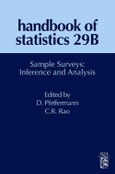Handbook of Statistics_29B contains the most comprehensive account of sample surveys theory and practice to date. It is a second volume on sample surveys, with the goal of updating and extending the sampling volume published as volume 6 of the Handbook of Statistics in 1988. The present handbook is divided into two volumes (29A and 29B), with a total of 41 chapters, covering current developments in almost every aspect of sample surveys, with references to important contributions and available software. It can serve as a self contained guide to researchers and practitioners, with appropriate balance between theory and real life applications.
Each of the two volumes is divided into three parts, with each part preceded by an introduction, summarizing the main developments in the areas covered in that part. Volume 1 deals with methods of sample selection and data processing, with the later including editing and imputation, handling of outliers and measurement errors, and methods of disclosure control. The volume contains also a large variety of applications in specialized areas such as household and business surveys, marketing research, opinion polls and censuses. Volume 2 is concerned with inference, distinguishing between design-based and model-based methods and focusing on specific problems such as small area estimation, analysis of longitudinal data, categorical data analysis and inference on distribution functions. The volume contains also chapters dealing with case-control studies, asymptotic properties of estimators and decision theoretic aspects.
Please Note: This is an On Demand product, delivery may take up to 11 working days after payment has been received.
Table of Contents
Part 1. Sampling and Survey Design Introduction to Part 1 1. Introduction to Survey Sampling 2. Sampling with Unequal Probabilities 3. Two-Phase Sampling 4. Multiple-Frame Surveys 5. Designs for Surveys over Time 6. Sampling of Rare Populations 7. Design, Conduct, and Analysis of Random-Digit Dialing Surveys
Part 2. Survey Processing Introduction to Part 2 8. Nonresponse andWeighting 9. Statistical Data Editing 10. Imputation and Inference in the Presence of Missing Data 11. Dealing with Outliers in Survey Data 12. Measurement Errors in Sample Surveys 13. Computer Software for Sample Surveys 14. Record Linkage 15. Statistical Disclosure Control for Survey Data
Part 3. Survey Applications Introduction to Part 3 16. Sampling and Estimation in Household Surveys 17. Sampling and Estimation in Business Surveys 18. Sampling, Data Collection, and Estimation in Agricultural Surveys 19. Sampling and Inference in Environmental Surveys 20. Survey Sampling Methods in Marketing Research: A Review of Telephone, Mall Intercept, Panel, andWeb Surveys 21. Sample Surveys and Censuses 22. Opinion and Election Polls Volume 29B: Inference and Analysis
Part 4. Alternative Approaches to Inference from Introduction to Part 4 23. Model-Based Prediction of Finite Population Totals 24. Design- and Model-Based Inference for Model Parameters 25. CalibrationWeighting: Combining Probability Samples and Linear Prediction Models 26. Estimating Functions and Survey Sampling 27. Nonparametric and Semiparametric Estimation in Complex Surveys 28. Resampling Methods in Surveys 29. Bayesian Developments in Survey Sampling 30. Empirical Likelihood Methods
Part 5. Special Estimation and Inference Problems 31. Design-based Methods of Estimation for Domains and Small Areas 32. Model-Based Approach to Small Area Estimation 33. Design and Analysis of Surveys Repeated over Time 34. The Analysis of Longitudinal Surveys 35. Categorical Data Analysis for Simple and Complex Surveys 36. Inference on Distribution Functions and Quantiles 37. Scatterplots with Survey Data
Part 6. Informative Sampling and Theoretical Aspects 38. Population-Based Case-Control Studies 39. Inference under Informative Sampling 40. Asymptotics in Finite Population Sampling 41. Some Decision-Theoretic Aspects of Finite Population Sampling
Author
Pfeffermann, Danny.Rao, C.R.
C. R. Rao, born in India is one of this century's foremost statisticians, received his education in statistics at the Indian Statistical Institute (ISI), Calcutta. Rao is currently at Penn State as Eberly Professor of Statistics and Director of the Center for Multivariate Analysis. His research has influenced not only statistics, but also the physical, social and natural sciences and engineering.








